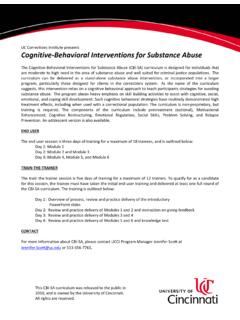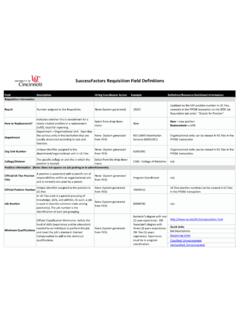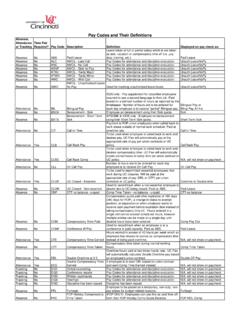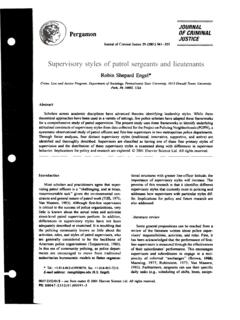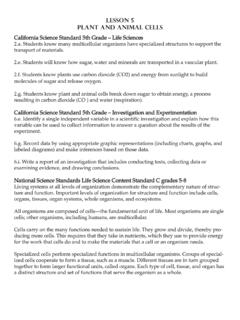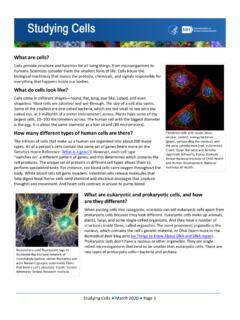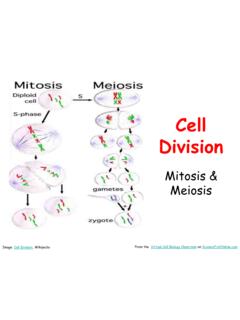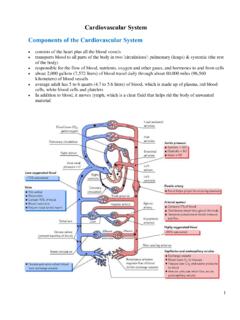Transcription of The Endocrine System - University of Cincinnati
1 The Endocrine SystemCOMPILED BY HOWIE BAUMTHE Endocrine SYSTEMA lthough often overshadowed by the brain and nerves, the Endocrine System is also involved in the information business. Hormones carry essential messages that have far-reaching effects. They control body processes at every level, from energy uptake of a single cell to the whole body s rate of growth and development. There are 50 of hormones, which are the body s chemical messengers and they are made by 12 different Endocrine glands. These glands have no ducts but secrete their hormones directly into the blood, by which means they reach every cell in the body.
2 Hormones affect certain target tissues or organs and regulate their Endocrine System sends hormones through the Circulatory System to control and coordinate body functions in much the same way as the nervous System uses tiny electrical signals. The Endocrine System and the Nervous System work together to integrate in the brain and complement each other, but they tend to work at different speeds. Nerves respond within split-seconds but their action soon fades Some hormones have longer lasting effects and act over hours, weeks, and years. Hormones regulate processes such as: The breakdown of chemical substances in metabolism of what we eat and drink Fluid balance and urine production The body s growth and development Sexual reproduction.
3 THE 12 PARTS OF THE Endocrine SYSTEMThe hypothalamus and the pituitary gland are part of the diencephalon region of the hypothalamus connects the nervous System to the Endocrine System . It receives and processes signals from other brain regions and pathways and translates them into hormones, the chemical messengers of the Endocrine System . These hormones flow to the pituitary gland, which is connected to the hypothalamus by the infundibulum. Some hormones are stored in the pituitary stores for later release; others spur it to secrete its own hormones. The hormones released by the pituitary gland and the hypothalamus control the other Endocrine glands and regulate all major internal thymus gland produces progenitor cells , which mature into T- cells (thymus-derived cells ).
4 The body uses T- cells to help destroy infected or cancerous cells . T- cells created by the thymus also help other organs in the immune System grow properly. These cells are so vital, they are often donated to those in need. The Thymus gland is the primary donor of cells for the lymphatic System , much as bone marrow is the cell donor for the cardiovascular ADRENAL GLANDS REGULATE SUBSTANCE LEVELS IN THE BLOOD AND RELEASE FIGHT-OR-FLIGHT HORMONESThe adrenal glands are pyramid-shaped organs that sit at the top of each kidney. Each adrenal gland consists of two structures: an outer adrenal cortex and an inner adrenal medulla.
5 The adrenal cortex is a network of fine connective tissues that makes up most of the gland. It secretes a range of steroid hormones. Cortisol which manages protein and glucose levels. Aldosterone which adjusts our levels of water and salt. Androgens and estrogens are secreted by the adrenal cortex in small amounts by both sexes. The adrenal medulla (inside the gland) produces epinephrine and nor-epinephrine (NE). These chemicals promote fight-or-flight, the body s initial response to left kidney is located slightly higher than the right kidney due to the larger size of the liver on the right side of the body2 HORMONES MADE BY THE KIDNEYSThe kidneys make two main hormones, vitamin D and Dis essential for a number of different functions in the of the vitamin D that is in the blood is inactive and it is modified by the kidney and other tissues to activate it.
6 Active vitamin D stimulates the uptake of calcium from food, is important for the maintenance of healthy bones and also helps to regulate the response of the immune System to produced when oxygen levels in the blood are low. It acts in bone marrow to stimulate the production of mature red blood cells and to maintain healthy oxygen levels in our GLANDS AND HORMONESThe main sex glands are the ovaries in females and testes in males. The sex hormones they produce stimulate the production of eggs and sperm respectively and influence the early development of the embryo into a boy or girl. After birth, the circulating levels remain low until puberty.
7 Then, in males, the testes increase their output of androgens (male sex hormones), such as testosterone. In females, the ovaries produce more oestrogensand PINEAL GLANDThe pineal gland is small and pine cone-shaped, (which is how it got its name) located at the back of the diencephalon region in the brain. At night, in the absence of light, the pineal gland secretes the hormone melatonin. Melatonin regulates the body s sleep patterns in both circadian (daily) and seasonal patterns. In the morning, when light hits the eye, photo receptors in the retina send signals to the pineal gland, which then decreases melatonin production and we wake GLANDThe pituitary is the most influential gland in the Endocrine System .
8 It is actually two distinct glands in one. Its front, or anterior lobe manufactures 7 major hormones and releases them into the bloodstream. Behind it is the posterior (back) lobe which receives its two main hormones from the hypothalamus, which lies above it and then it releases 3 hormones, as #anterior-pituitaryPITUITARY GLANDThe Hypothalamus Sends Hormones to the Pituitary Gland to Control the Endocrine SystemTHE THYROID AND PARATHYROID GLANDS INCREASE METABOLISM AND REGULATE CALCIUM LEVELSTHYROID GLANDThe thyroid gland sits in the throat region, just below the larynx, served by large arteries with many branches and a dense network of capillaries.
9 The hormones it secretes, travel in the bloodstream throughout the body to: Increase metabolism Regulate glucose use Protein synthesis Nervous System development. It also releases Calcitonin, which helps maintain blood calcium homeostasis by causing calcium to be removed from the blood and deposited into bones when blood (calcium) levels are too GlandsOn the posterior (back) surface of the thyroid sit much smaller, separate glands: the there are four parathyroid glands, a superior and inferior pair on the left and right sides of the thyroid. They secrete parathyroid hormone (PTH), which stimulates bones to release calcium into the blood when blood (calcium) levels are low.
10 PTH also causes the kidneys to reduce calcium secretion into urine to further elevate calcium levels in the blood. Together, calcitonin and PTH act in complementary ways to maintain blood calcium homeostasis, which is one of the most tightly controlled physiological parameters in the to 50 is an element that's required for the thyroid gland to produce thyroid the body does not produce iodine on its own, it needs to come from dietary sources and striking the right balance is key. The Importance of IodineWhen you consume iodine, it is quickly absorbed and entered into your thyroid, which has tiny cells that capture the circulating iodine, takes in and oxidizes it so it can begin to be used to create T3 and T4 thyroid hormones that make their way throughout the body to regulate metabolism and ensure healthy functioning of the heart, brain, and other organs.



